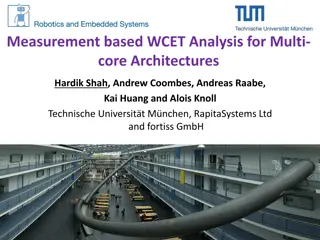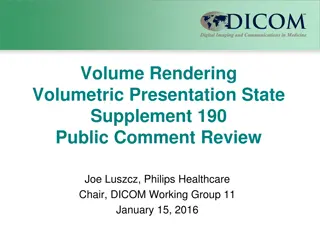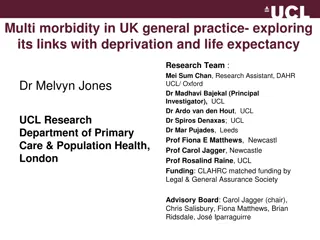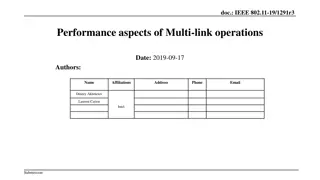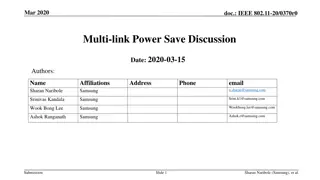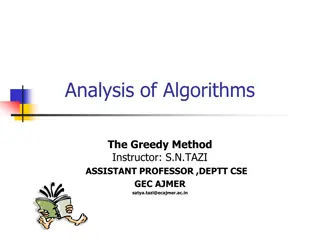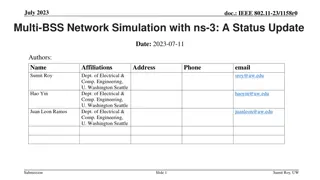Solicited Method for Critical Update in Multi-Link Environments
This document discusses a method for obtaining critical update information for Access Points (APs) within the same Multi-Link Domain (MLD) in IEEE 802.11 standards. It introduces the concept of Change Sequence fields in Beacon and Probe Response frames to indicate changes in system information for other APs. The proposed solicited method aims to efficiently gather critical update information for APs, especially when a Station (STA) in a non-AP MLD notices changes in another AP and needs to update its parameters. The method improves the process of obtaining updated system information in a multi-link environment, enhancing overall network efficiency.
Download Presentation

Please find below an Image/Link to download the presentation.
The content on the website is provided AS IS for your information and personal use only. It may not be sold, licensed, or shared on other websites without obtaining consent from the author. Download presentation by click this link. If you encounter any issues during the download, it is possible that the publisher has removed the file from their server.
E N D
Presentation Transcript
October 2020 doc.: IEEE 802.11-20/1737r1 Solicited method for critical update in multi-link Date: 2020-10-26 Authors: Name Affiliations Address Email Namyeong Kim namyeong.kim@lge.com Jeongki Kim jeongki.kim@lge.com LG Seocho R&D Campus, Korea Insun Jang insun.jang@lge.com LG Electronics Sunhee Baek sunhee.baek@lge.com Jinsoo Choi js.choi@lge.com Submission Slide 1 Namyeong Kim, LGE
October 2020 doc.: IEEE 802.11-20/1737r1 Overview Previously, we had discussed about the method for providing the Change Sequence fields for other APs. We agreed that [1] : 802.11be supports that an AP within an AP MLD shall include in the Beacon and Probe Response frames it transmits the Change Sequence fields that indicate changes of system information for other APs within the same AP MLD, where the change sequence field value for the reported AP is initialized to 0, that increments as the critical update of the reported AP is occurred. In 11be, a STA of non-AP MLD can obtain the Change Sequence number for other APs from Beacon or Probe Response frame. Submission Slide 2 Namyeong Kim, LGE
October 2020 doc.: IEEE 802.11-20/1737r1 Motivation When a STA of a non-AP MLD notices that the Change Sequence field for another link has changed, If the another STA (i.e. STA that is connected with the another link) of same non-AP MLD is in awake state, the another STA can try to listen the next Beacon of another link to obtain the updated parameters. If the another STA of same non-AP MLD is in doze state, the another STA need to awake from doze to listen the next Beacon of the another link to obtain the updated parameters. As a result, the another STA shall awake to gather the updated parameters from its Beacon and this may be inefficient when the another STA is in doze state. Submission Slide 3 Namyeong Kim, LGE
October 2020 doc.: IEEE 802.11-20/1737r1 Recap: the method for critical update in 11ah In 11ah spec., it provides a method for the STA to retrieve the updated system information of the AP. The S1G STA shall either be awake to receive the next S1G Beacon frame that is transmitted at a TBTT or shall queue for transmission a Probe Request frame when it receives a Change Sequence field that contains a value that is different from the previously received Change Sequence field. When an S1G STA transmits a Probe Request frame to obtain the updated system information, it may include the Change Sequence element in the Probe Request frame to request a compressed Probe Response frame. When an S1G AP receives a Probe Request frame that contains a Change Sequence element from an S1G STA associated with the S1G AP, it compares the value of the received Change Sequence field with the value of its current Change Sequence field. If the value of the received Change Sequence field is not equal to the value of the current Change Sequence field, the S1G AP should send a compressed Probe Response frame, which is a Probe Response frame that includes the Change Sequence element and only the elements that need be updated by the STA. Submission Slide 4 Namyeong Kim, LGE
October 2020 doc.: IEEE 802.11-20/1737r1 Proposal 11be allows a STA of a non-AP MLD to request a part of complete information of other APs of the same AP MLD [2]. We can utilize this concept for a STA of a non-AP MLD to request only elements regarding the critical update event of other APs. We propose the solicited method to obtain critical update information for other APs of same AP MLD. In this contribution, critical update information means the elements which are classified as critical update events in 11be. Submission Slide 5 Namyeong Kim, LGE
October 2020 doc.: IEEE 802.11-20/1737r1 Proposal: The solicited method for critical update (1/2) A STA of non-AP MLD may send an MLD probe request to obtain updated critical information of other APs. The STA shall include the most recently received CSN (change sequence number) information in the MLD probe request. Note: we agreed that a non-AP MLD shall maintain a record of the most recently received change sequence number for each reported APs in the AP MLD with which it has multi- link setup. Submission Slide 6 Namyeong Kim, LGE
October 2020 doc.: IEEE 802.11-20/1737r1 Proposal: The solicited method for critical update (2/2) On receiving the MLD probe request containing the CSN information of the STA(s), an AP of AP MLD sends a MLD probe response containing the critical update information with the current CSN of other APs. If the AP MLD implements to support the tracking of updated elements per each CSN, the AP may send a MLD probe response including only partial elements that need to be updated by the STA among critical update information. The AP can know which elements are updated comparing the current CSN of AP with the record of CSN of STA received based on the tracking record of updated element(s) per each CSN. For this, the record of element ID is enough to track the updated element(s) per each CSN. If the AP MLD does not implement to support the tracking of updated elements per each CSN, the AP may send a MLD probe response including all elements that classified as critical update events in 11be. Submission Slide 7 Namyeong Kim, LGE
October 2020 doc.: IEEE 802.11-20/1737r1 The signaling for the solicited method We provide two options for a signaling to indicate the request of critical update information for other APs. Option 1: Use of Change Sequence element Option 2: Use of Change Sequence field with a control field Submission Slide 8 Namyeong Kim, LGE
October 2020 doc.: IEEE 802.11-20/1737r1 Option 1: Use of Change sequence element We can borrow a concept of existing Change Sequence element (11ah) to indicate the request of critical update information for other APs. A STA may request critical update information of other APs by sending a MLD probe request including a Change Sequence element. MLD probe request Submission Slide 9 Namyeong Kim, LGE
October 2020 doc.: IEEE 802.11-20/1737r1 Option 2: Use of Change Sequence field with a control field We can use a Change Sequence field to indicate the request of critical update information for other APs. For this, we also define a new control field to indicate the presence of the Change Sequence field in ML element (i.e. Probe Request variant Multi-Link element). For example, the control field name may be critical update request . The exact name is TBD. A STA may request critical update information of other APs by sending a request message including a Change Sequence field with a control field. MLD probe request Submission Slide 10 Namyeong Kim, LGE
October 2020 doc.: IEEE 802.11-20/1737r1 Option 1 vs Option 2 Option 1 This option is simple using existing Change Sequence element. We don t need to define a new field or element. But, the overhead for default field (e.g. element ID, length field) may occur each Per-STA Profile. When the STA requests information on multiple APs, this overhead may increase further. Option 2 (preferred) This option requires a new field. However, the new field is just 1bit (e.g. Critical update Request field) But, the overhead for default field can be reduced by using the change sequence field (not element). As a result, we prefer the Option 2 to avoid duplicated information transmission and reduce overhead. We may use ML IE format to indicate request of critical update information of specific link(s). Submission Slide 11 Namyeong Kim, LGE
October 2020 doc.: IEEE 802.11-20/1737r1 Conclusion We propose the solicited method to retrieve the critical update information for one or more AP(s). Using this method, a STA may obtain only elements that classified as critical update events in 11be of other APs. In this regard, we provide 2 options for the signaling to request the critical update information. We slightly prefer the option 2 for the solicited method because it has lower overhead than the option 1. Submission Slide 12 Namyeong Kim, LGE
October 2020 doc.: IEEE 802.11-20/1737r1 SP #1 Do you agree to add the following to 11be SFD: A STA of a non-AP MLD may send a Probe Request frame to the peer AP to obtain updated BSS parameters of another AP of the AP MLD with which the non-AP MLD has setup. The Probe Request frame is ML Probe Request. Submission Slide 13 Namyeong Kim, LGE
October 2020 doc.: IEEE 802.11-20/1737r1 SP #2 Do you agree to add the following to 11be SFD: When a STA of a non-AP MLD sends ML Probe Request to the peer AP to obtain updated BSS parameters of another AP of the AP MLD with which the non-AP MLD has setup, it shall include the value of the most recently received change sequence field of the another AP in the ML Probe Request. The exact name of change sequence field is TBD. Submission Slide 14 Namyeong Kim, LGE
October 2020 doc.: IEEE 802.11-20/1737r1 SP #3 Do you agree to add the following to 11be SFD: When a STA of a non-AP MLD sends a ML Probe Request to the peer AP to obtain updated BSS parameter(s) of another AP of the AP MLD with which the non-AP MLD has setup, it shall include the value of the most recently received change sequence field in Per-STA Profile of ML IE carried in the ML Probe Request. The exact name of change sequence field is TBD. Submission Slide 15 Namyeong Kim, LGE
October 2020 doc.: IEEE 802.11-20/1737r1 SP #4 Do you agree to add the following to 11be SFD: When a STA of a non-AP MLD sends a ML Probe Request containing a ML IE with change sequence field to the peer AP, the Complete Profile subfield in Per-STA Profile subelement of ML IE is set to 0. The exact name of change sequence field is TBD. Submission Slide 16 Namyeong Kim, LGE
October 2020 doc.: IEEE 802.11-20/1737r1 SP #5 Which option do you prefer as a signaling to retrieve the updated BSS parameter(s) for another AP of AP MLD with which the non-AP MLD has setup? Option 1: Use Change Sequence element Option 2: Use of Change Sequence field with a control field Abstain Submission Slide 17 Namyeong Kim, LGE
October 2020 doc.: IEEE 802.11-20/1737r1 References [1] 11-20/0586: MLO Signaling of critical updates (Abhishek Patil, Qualcomm) [2] 11-20/0411: MLO Information exchange for Link switching (Namyeong Kim, LG Electronics) Submission Slide 18 Namyeong Kim, LGE












